
 Custom Search
|
|
| sails |
| plans |
| epoxy |
| rope/line |
| hardware |
| canoe/Kayak |
| sailmaking |
| materials |
| models |
| media |
| tools |
| gear |
 |
 |
| join |
| home |
| indexes |
| classifieds |
| calendar |
| archives |
| about |
| links |
| Join Duckworks Get free newsletter Comment on articles CLICK HERE |
|
|
| Small Boat Stoves - Part Two |
by Bill Nolen - Oklahoma City - USA |
| Part one - Part Two - Part Three Last month Bill Nolen wrote about the different types of alcohol stoves that can be used on small boats. This month in Part two he writes about Butane and Propane stoves. Butane Stoves: There are several similar small Butane fueled, single burner stoves, such as the Kenyon Express ll Stove, and the Mr. Max Burton Stove, as well as many other different named Asian made brands available for boating use. International Marine Co. installs the Mr. Max Burton stove in the cabins of their new West Wight Potter 19-foot Sailboats.
These type stoves are not actually designed for marine use, but have held up very well in the marine environment. If you are concerned about marine use there are stainless steel stoves of the same design. One is the Burton Pro Chief Table Top Burner, Model 8259E.
This style of stoves can be found in most large Asian Food Markets, where they are called Portable Gas Stoves. At these markets the cost of a stove and fuel cartridges is very reasonable. In the past I have purchased two of the Gasone Brand Model EZS-1000 manufactured in Korea. The price was $16.95 for the stove and caring case, and $3.44 for four 8-oz butane cartridges. Last week I saw the same stove for sale at a hardware store for $12.95. The hard case makes it easy to carry and store on a boat.
These stoves take up a space of about 11-inches by 13-inches, with a height of 4-inches, and weigh about 6-pounds. They use only the 8-oz butane fuel cartridge that is contained within the stove. The cartridge is locked into place by pushing down on a locking single lever. A cartridge can be inserted or removed in about 15-seconds, and reused until the cartridge is empty. A cartridge will provide about 3-hours of cooking at the high burner setting. One nice feature of these stoves is the piezoelectric self-ignition. Just turn a knob and the stove is lit. I had not used my stove for several months, but, after locking a partly use cartridge into place, the stove lit with the first turn of the control knob! To test the water heating ability I placed on a stove 2-cups of water in a 1 1/2-quart aluminum pan. It took 4-minutes and 19-seconds to bring the two-cups of water to a boil. I believe the cooking/heating ability of the less expensive stoves Portable Gas Stoves is as good as the Kenyon and Burton models. However, the Kenyon and Burton portable butane stoves do have optional mounting kits, and also pot holder kits that should keep a pot from coming off the stove. These options may or may not fit on the less expensive Portable Gas Stoves. Mark Larson has written a good article on how he installed a Max Burton stove. You can read it HERE. Propane Stoves:There are at least two or more small one-burner stove that is actually designed for marine use. That is the free-swinging gimbaled style stove, which is presently being manufactured by two different companies, Force 10 Marine Company, and the Forespar Products Corporation. Force 10 makes the Seacook Model 82000, and Forespar makes the Mini-Galley 2000. Notice: Force 10 has stopped manufacturing the Seacook 82000. The information below is provided in the case a person may still be able to purchase a new or used one. The Mini-Gallery 2000 comes with a one-quart stainless steel cooking pot and a lid that also serves as a frying pan. The pot and lid come stored in a nice polyester storage sack that nests inside the stove. Both stoves come with simple mounting brackets that allow easy attachment to a bulkhead or wall. These mounting brackets permit quick placement and removal of the stoves for storage. Both stoves have pot-restraining devices to hold pots in place. The two stoves are very completive in pricing, with the Seacook listed for $99.99 and the Mini-Galley listed for $153.99 in the 2011 Defender Marine Online Catalog.
Sailboat sailors have used one-burner gimbaled marine stoves for many years. Sterno Canned Heat (denatured & jellied alcohol) was used for the fuel supply on the earlier marine gimbaled stoves. Robert Manry used a Sterno Canned Heat gimbaled stove on his 13 1/2-foot sailboat "Tinkerbelle" during his 78-day Atlantic Ocean Crossing in 1965. Today the above listed gimbaled stoves use a 16.4-oz. propane cartridge that easily attach's to, and detaches from, the bottom of the stoves. A single propane cartridge will provide about 3 1/2-hours of cooking time at the high burner setting. The Seacook 82000 and the Mini-Galley 2000 stoves are both made of stainless steel. However, the overall construction of the two stoves is quite different, with the Seacook stove being much more robust, larger in size, and weighing more than twice as much as the Mini-Galley. The Seacook stove measures 10 1/2-inches in width, and 16-inches in height from the top edge of the stove to the bottom of the propane cartridge. The weight of the stove without a propane cartridge is
The Mini-Galley stove is much smaller in size than the Seacook. It measures 7 1/4-inches in width, and 14 1/2-inches in height from the top edge of the weight of the stove without a propane cartridge is 1 With a starting cold-water temp of 75-degrees, it took 4.5-minutes to bring two-cups of water to a boil on the Seacook stove. With the same test conditions, it took only 1-minute to bring two-cups of water to a boil on the Mini-Galley stove. To insure that these test were accurate, I ran the tests again and got the same results with both stoves. The Mini-Galley stove can bring water to a boil faster than any other propane stove that I have ever used! While conducting these test I noted that the Seacook stove had an enclosed burner, thus providing a containment area for any pot overflow, while the open area under the burner on the Mini-Galley did not provide this protection.
After testing both the Seacook and the Mini-Galley stoves I believe that both stoves have their positive and negative points. The Seacook is slightly larger than I desire, but the robust construction is outstanding. An owner can easily replace any part that might wear out or become damaged. In addition, the ability to easily control the heat level is very desirable, as well as being able to use many household pots and pans with the stove. The Mini-Galley is a perfect size for a micro-cruiser like the West Wight Potter 15. However, the method of construction of the stove limits any repairs that an owner might be able to make. All components, other than the fuel control valve, are welded or riveted in place. In addition, the stove's basket style construction does limit the size and style of pots and pans that can be used with the stove. To use the stove a person must lower a pot down into the basket like structure, or slide the small fry pan into the basket. A person should use an oven mitten when attempting to remove the pot lid from the pot when cooking since the lid must be removed without the aid of a knob or handle. While the basket design greatly reduces the danger of a pot sliding off the stove, it does limit the size of any pot to about 5 1/4-inchs in diameter. Forespar does have an optional aluminum coffee percolator, and SS teapot available that are made for the stove. Here is a photo showing a Seacook installed in the cabin of a Freedom 25 sailboat.
Camping-Backpacking-Type Stoves There appear to be more different brands and styles of small lightweight propane camping stoves on the market than fish in the seas! There are hundreds of small single burner backpacker style propane fueled stoves on the market. Most are very easy to use for the most part. A propane cartridge is attached to the stove, either directly or by means of a connecting hose. A burner valve is turned on and the fumes are lit with a match or a piezoelectric self-ignition. From comments I have seen, and my personal experience, it appears the main disadvantage to using these small stoves is that most are not very stable with a pan or skillet on the burner. A buyer should carefully determine whether or not the folding pot support arms lock into place or are easily dislodged. Skipper Travis Votaw modified his propane stove by mounting it to a 9-inch skillet and a wooden base as shown in this photo.
Mike Higgins has built a remarkable Cook Box that not only keeps his Primus Yellowstone propane stove from tipping over, it also has room to store all his cook set, and much more! You can view more details here: Mike Higgins Cook Box The stoves that attach directly to a fuel canister are usually attached by having the canister attach directly onto the bottom of the stoves valve. Most stove manufactures state their stoves should be used only with the manufactures brand of fuel canister. However, many test reports I have read state the stoves will work just as well using cheaper fuel canisters. It is my understanding that there is more than one industry accepted valves for stove canisters. Therefore a person should be sure when buying replacement canisters that the canister will fit their stove. The main disadvantage of these stoves is that the larger the fuel canister the less stable the stove and pot becomes. The advantage of this style stove is that it in compact and stores in a very small space.
Some different makes and types of backpacking/camping propane canister stoves
Complete Field test of this stove can be found HERE.
Primus Micron TI Stove, and different sizes of fuel canisters are available.
Snow Peak Giga Stove
One advantage of the stove with a hose attached fuel canister is the low profile of the stove, thus giving it more stability. As can be seen the disadvantage is that the stove, hose, and canister take up more surface and storage space. Frankly, I have difficulty telling one small backpacking stove from another one! When carrying a backpack no doubt light weigh and smallness matter. However, even on a small sailboat an extra pound or so does not make much difference. Finding room to store and use the stove is more important than weight as far as I am concerned. Note: Some stove manufacturers recommends canisters containing an isobutane and propane mixture to insure a cleaner and hotter burning flame at high-altitudes.
If you believe that you must have a two-burner stove, the new Coleman Fold n Go stove is just the thing. It's about 25% more compact in size compared to traditional 2 burner stoves. It's easy to carry, and simple to store. Folds out into two full-size cooking areas. Has two 10,000 BTU burners. Regulator and cooking grates store inside stove when not in use. Burners are adjustable from low to high cooking heat. InstaStartT gives fast, dependable lighting without matches. Operates on standard 16.4 oz Coleman propane cylinder.
Part three next month will feature solid fuel boat stoves. https://www.wwpotterowners.com ***** Here's a list of Bill's previous articles:Harmonica - Part 1 - 2 - 3 - 4 - 5 - 6 - 7 A Simple Anchoring System (The Treasure Chest) Front Tiller (The Treasure Chest) |
 |

 Gasone EZS-1000 with the 8-oz butane and a 16.4-oz propane cartridge that some stoves use.
Gasone EZS-1000 with the 8-oz butane and a 16.4-oz propane cartridge that some stoves use.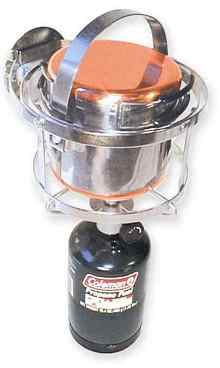 Forespar Mini-Galley 2000 Force 10 Seacook 82000 Stove
Forespar Mini-Galley 2000 Force 10 Seacook 82000 Stove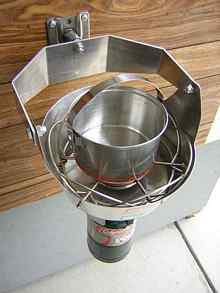
 Forespar Mini-Galley Pot and Fry Pan
Forespar Mini-Galley Pot and Fry Pan Skipper Bill McClure's cooking on Seacook stove. Photo credit: Derek Jensen
Skipper Bill McClure's cooking on Seacook stove. Photo credit: Derek Jensen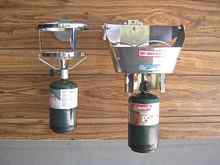 Test stand with the Mini-Galley stove and the Seacook stove
Test stand with the Mini-Galley stove and the Seacook stove Mini-Galley stove with open burner Seacook stove with enclosed burner
Mini-Galley stove with open burner Seacook stove with enclosed burner
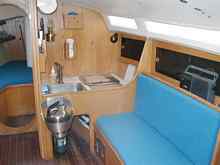

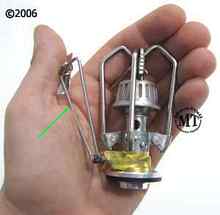 MSR Rocket Pocket Stove and Pot Snow Peak Giga Stove Folded
MSR Rocket Pocket Stove and Pot Snow Peak Giga Stove Folded 
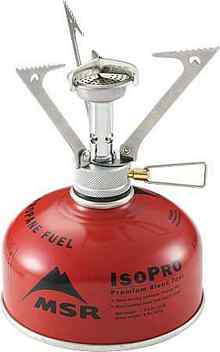 MSR Pocket Rocket Canister Stove
MSR Pocket Rocket Canister Stove


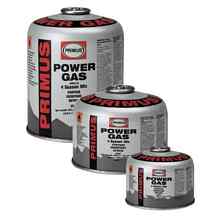
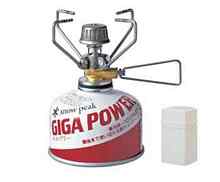

 Coleman Fold-n-Go two-burner Stove.
Coleman Fold-n-Go two-burner Stove.